2009 Seat Ibiza SC child seat
[x] Cancel search: child seatPage 5 of 257
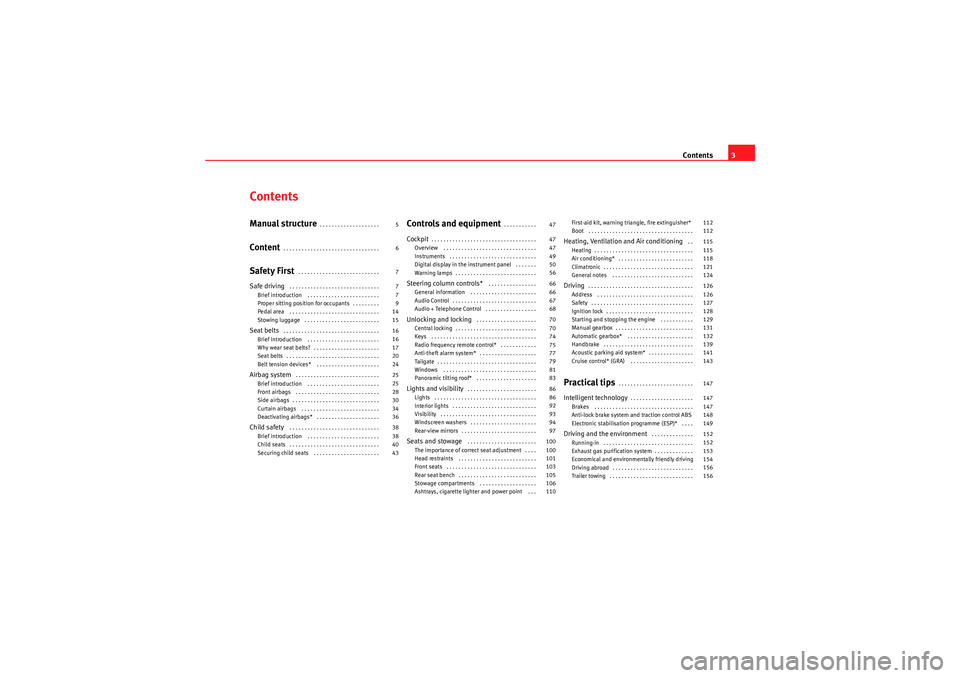
Contents3
ContentsManual structure
. . . . . . . . . . . . . . . . . . . .
Content
. . . . . . . . . . . . . . . . . . . . . . . . . . . . . . . .
Safety First
. . . . . . . . . . . . . . . . . . . . . . . . . . .
Safe driving
. . . . . . . . . . . . . . . . . . . . . . . . . . . . . .
Brief introduction . . . . . . . . . . . . . . . . . . . . . . . .
Proper sitting position for occupants . . . . . . . . .
Pedal area . . . . . . . . . . . . . . . . . . . . . . . . . . . . . .
Stowing luggage . . . . . . . . . . . . . . . . . . . . . . . . .
Seat belts
. . . . . . . . . . . . . . . . . . . . . . . . . . . . . . . .
Brief Introduction . . . . . . . . . . . . . . . . . . . . . . . .
Why wear seat belts? . . . . . . . . . . . . . . . . . . . . . .
Seat belts . . . . . . . . . . . . . . . . . . . . . . . . . . . . . . .
Belt tension devices* . . . . . . . . . . . . . . . . . . . . .
Airbag system
. . . . . . . . . . . . . . . . . . . . . . . . . . . .
Brief introduction . . . . . . . . . . . . . . . . . . . . . . . .
Front airbags . . . . . . . . . . . . . . . . . . . . . . . . . . . .
Side airbags . . . . . . . . . . . . . . . . . . . . . . . . . . . . .
Curtain airbags . . . . . . . . . . . . . . . . . . . . . . . . . .
Deactivating airbags* . . . . . . . . . . . . . . . . . . . . .
Child safety
. . . . . . . . . . . . . . . . . . . . . . . . . . . . . .
Brief introduction . . . . . . . . . . . . . . . . . . . . . . . .
Child seats . . . . . . . . . . . . . . . . . . . . . . . . . . . . . .
Securing child seats . . . . . . . . . . . . . . . . . . . . . .
Controls and equipment
. . . . . . . . . . .
Cockpit
. . . . . . . . . . . . . . . . . . . . . . . . . . . . . . . . . . .
Overview . . . . . . . . . . . . . . . . . . . . . . . . . . . . . . .
Instruments . . . . . . . . . . . . . . . . . . . . . . . . . . . . .
Digital display in the instrument panel . . . . . . .
Warning lamps . . . . . . . . . . . . . . . . . . . . . . . . . . .
Steering column controls*
. . . . . . . . . . . . . . . .
General information . . . . . . . . . . . . . . . . . . . . . .
Audio Control . . . . . . . . . . . . . . . . . . . . . . . . . . . .
Audio + Telephone Control . . . . . . . . . . . . . . . . .
Unlocking and locking
. . . . . . . . . . . . . . . . . . . .
Central locking . . . . . . . . . . . . . . . . . . . . . . . . . . .
Keys . . . . . . . . . . . . . . . . . . . . . . . . . . . . . . . . . . .
Radio frequency remote control* . . . . . . . . . . . .
Anti-theft alarm system* . . . . . . . . . . . . . . . . . . .
Tailgate . . . . . . . . . . . . . . . . . . . . . . . . . . . . . . . . .
Windows . . . . . . . . . . . . . . . . . . . . . . . . . . . . . . .
Panoramic tilting roof* . . . . . . . . . . . . . . . . . . . .
Lights and visibility
. . . . . . . . . . . . . . . . . . . . . . .
Lights . . . . . . . . . . . . . . . . . . . . . . . . . . . . . . . . . .
Interior lights . . . . . . . . . . . . . . . . . . . . . . . . . . . .
Visibility . . . . . . . . . . . . . . . . . . . . . . . . . . . . . . . .
Windscreen washers . . . . . . . . . . . . . . . . . . . . . .
Rear-view mirrors . . . . . . . . . . . . . . . . . . . . . . . . .
Seats and stowage
. . . . . . . . . . . . . . . . . . . . . . .
The importance of correct seat adjustment . . . .
Head restraints . . . . . . . . . . . . . . . . . . . . . . . . . .
Front seats . . . . . . . . . . . . . . . . . . . . . . . . . . . . . .
Rear seat bench . . . . . . . . . . . . . . . . . . . . . . . . . .
Stowage compartments . . . . . . . . . . . . . . . . . . .
Ashtrays, cigarette lighter and power point . . . First-aid kit, warning triangle, fire extinguisher*
Boot . . . . . . . . . . . . . . . . . . . . . . . . . . . . . . . . . . .
Heating, Ventilation and Air conditioning
. .
Heating . . . . . . . . . . . . . . . . . . . . . . . . . . . . . . . . .
Air conditioning* . . . . . . . . . . . . . . . . . . . . . . . . .
Climatronic . . . . . . . . . . . . . . . . . . . . . . . . . . . . . .
General notes . . . . . . . . . . . . . . . . . . . . . . . . . . .
Driving
. . . . . . . . . . . . . . . . . . . . . . . . . . . . . . . . . . .
Address . . . . . . . . . . . . . . . . . . . . . . . . . . . . . . . .
Safety . . . . . . . . . . . . . . . . . . . . . . . . . . . . . . . . . .
Ignition lock . . . . . . . . . . . . . . . . . . . . . . . . . . . . .
Starting and stopping the engine . . . . . . . . . . .
Manual gearbox . . . . . . . . . . . . . . . . . . . . . . . . . .
Automatic gearbox* . . . . . . . . . . . . . . . . . . . . . .
Handbrake . . . . . . . . . . . . . . . . . . . . . . . . . . . . . .
Acoustic parking aid system* . . . . . . . . . . . . . . .
Cruise control* (GRA) . . . . . . . . . . . . . . . . . . . . .
Practical tips
. . . . . . . . . . . . . . . . . . . . . . . . .
Intelligent technology
. . . . . . . . . . . . . . . . . . . . .
Brakes . . . . . . . . . . . . . . . . . . . . . . . . . . . . . . . . .
Anti-lock brake system and traction control ABS
Electronic stabilisation programme (ESP)* . . . .
Driving and the environment
. . . . . . . . . . . . . .
Running-in . . . . . . . . . . . . . . . . . . . . . . . . . . . . . .
Exhaust gas purification system . . . . . . . . . . . . .
Economical and environmentally friendly driving
Driving abroad . . . . . . . . . . . . . . . . . . . . . . . . . . .
Trailer towing . . . . . . . . . . . . . . . . . . . . . . . . . . . .
5
6
7
7
7
9
14
15
16
16
17
20
24
25
25
28
30
34
36
38
38
40
43 47
47
47
49
50
56
66
66
67
68
70
70
74
75
77
79
81
83
86
86
92
93
94
97
100
100
101
103
105
106
110 112
112
115
115
118
121
124
126
126
127
128
129
131
132
139
141
143
147
147
147
148
149
152
152
153
154
156
156
IbizaSC_EN.book Seite 3 Mittwoch, 16. September 2009 12:11 12
Page 9 of 257
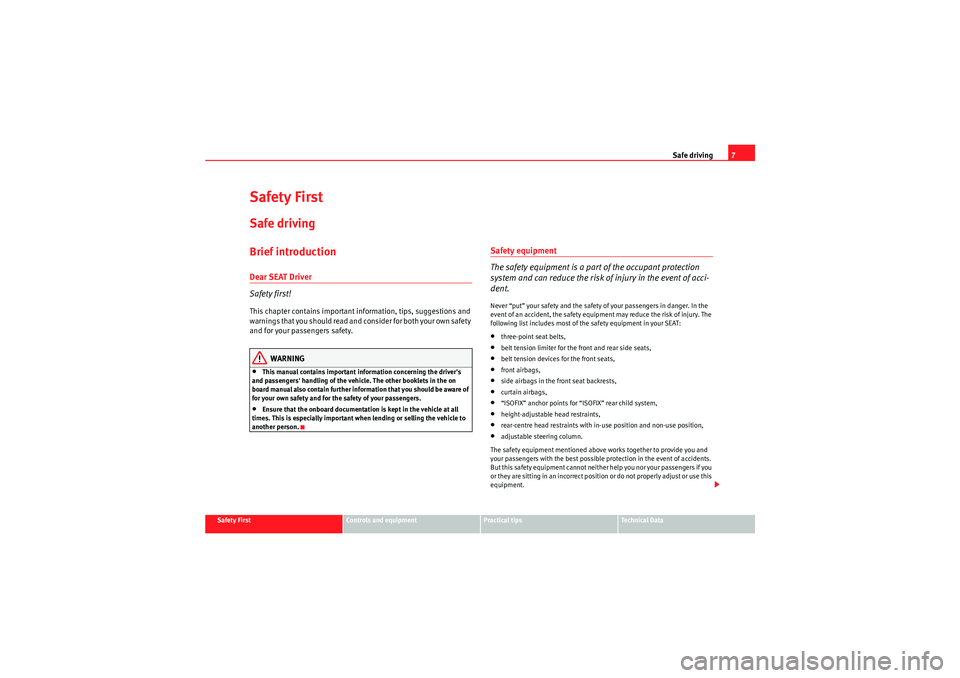
Safe driving7
Safety First
Controls and equipment
Practical tips
Technical Data
Safety FirstSafe drivingBrief introductionDear SEAT Driver
Safety first!This chapter contains important in formation, tips, suggestions and
warnings that you should read and consider for both your own safety
and for your passengers safety.
WARNING
•This manual contains important information concerning the driver's
and passengers' handling of the vehicle. The other booklets in the on
board manual also contain further information that you should be aware of
for your own safety and for the safety of your passengers.•Ensure that the onboard documentation is kept in the vehicle at all
times. This is especially important when lending or selling the vehicle to
another person.
Safety equipment
The safety equipment is a part of the occupant protection
system and can reduce the risk of injury in the event of acci-
dent.Never “put” your safety and the safety of your passengers in danger. In the
event of an accident, the safety equipment may reduce the risk of injury. The
following list includes most of the safety equipment in your SEAT:•three-point seat belts,•belt tension limiter for the front and rear side seats,•belt tension devices for the front seats,•front airbags,•side airbags in the front seat backrests,•curtain airbags,•“ISOFIX” anchor points for “ISOFIX” rear child system,•height-adjustable head restraints,•rear-centre head restraints with in-use position and non-use position,•adjustable steering column.
The safety equipment mentioned above works together to provide you and
your passengers with the best possible protection in the event of accidents.
But this safety equipment cannot neither help you nor your passengers if you
or they are sitting in an incorrect position or do not properly adjust or use this
equipment.
IbizaSC_EN.book Seite 7 Mittwoch, 16. September 2009 12:11 12
Page 10 of 257
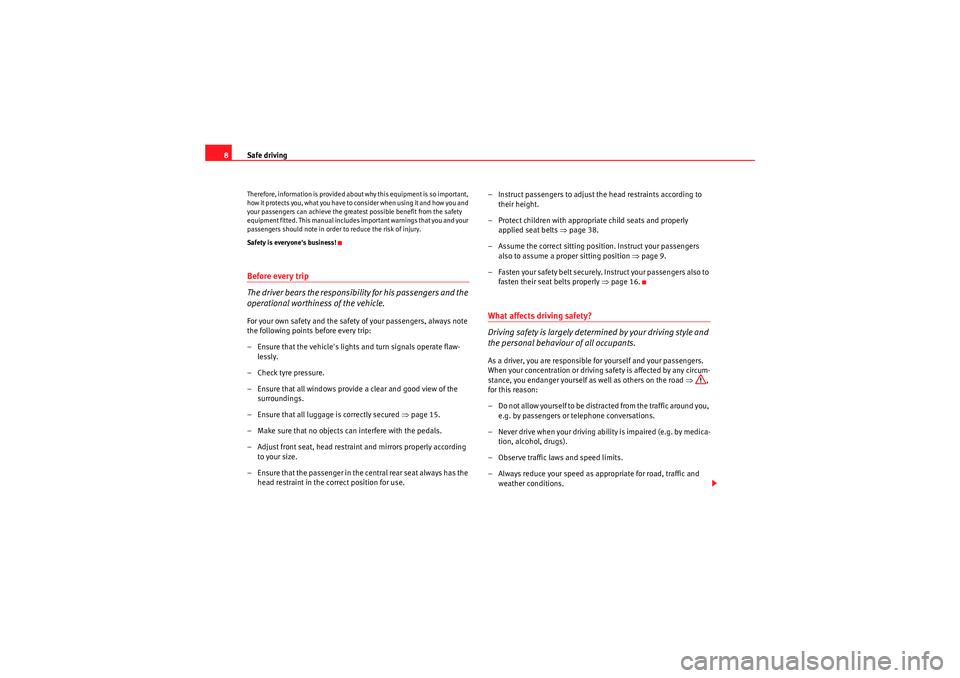
Safe driving
8Therefore, information is provided about why this equipment is so important,
h o w i t p r o t e c t s yo u , w h a t yo u ha v e to co n s i d e r w h e n u s i n g i t a n d h o w yo u a n d
your passengers can achieve the greatest possible benefit from the safety
equipment fitted. This manual includes important warnings that you and your
passengers should note in order to reduce the risk of injury.
Safety is everyone's business!Before every trip
The driver bears the responsibility for his passengers and the
operational worthiness of the vehicle.For your own safety and the safety of your passengers, always note
the following points before every trip:
– Ensure that the vehicle's lights and turn signals operate flaw-
lessly.
– Check tyre pressure.
– Ensure that all windows provide a clear and good view of the surroundings.
– Ensure that all luggage is correctly secured ⇒page 15.
– Make sure that no objects can interfere with the pedals.
– Adjust front seat, head restraint and mirrors properly according to your size.
– Ensure that the passenger in the central rear seat always has the head restraint in the co rrect position for use. – Instruct passengers to adjust the head restraints according to
their height.
– Protect children with appropriate child seats and properly applied seat belts ⇒page 38.
– Assume the correct sitting position. Instruct your passengers also to assume a proper sitting position ⇒page 9.
– Fasten your safety belt securely. Instruct your passengers also to fasten their seat belts properly ⇒ page 16.
What affects driving safety?
Driving safety is largely determined by your driving style and
the personal behaviour of all occupants.As a driver, you are responsible for yourself and your passengers.
When your concentration or driving safety is affected by any circum-
stance, you endanger yourself as well as others on the road ⇒,
for this reason:
– Do not allow yourself to be distracted from the traffic around you, e.g. by passengers or telephone conversations.
– Never drive when your driving abil ity is impaired (e.g. by medica-
tion, alcohol, drugs).
– Observe traffic laws and speed limits.
– Always reduce your speed as appropriate for road, traffic and weather conditions.
IbizaSC_EN.book Seite 8 Mittwoch, 16. September 2009 12:11 12
Page 13 of 257

Safe driving11
Safety First
Controls and equipment
Practical tips
Technical Data
•Adjust the front passenger seat so that there is at least 25 cm between
your breastbone and the dash panel. If distance is less than 25 cm, the
airbag system may not protect you properly.•If your physical constitution prevents you from maintaining the
minimum distance of 25 cm, contact a qualified workshop. The workshop
will help you decide if special specific modifications are necessary.•Always keep your feet in the footwell when the vehicle is moving; never
rest them on the instrument panel, ou t the window or on the seat. An incor-
rect sitting position exposes you to an increased risk of injury in case of a
sudden braking or an accident. If the airbag is triggered, you could sustain
severe injuries due to an incorrect sitting position.•To reduce the risk of injury to the front passenger in events such sudden
braking manoeuvres or an accident, never travel with the backrest tilted far
back! The airbag system and seat belts can only provide optimal protection
when the backrest is in an upright position and the front passenger is
wearing his or her seat belt properly. The further the backrests are tilted to
the rear, the greater the risk of injury due to incorrect positioning of the
belt web or to the incorrect sitting position!•Adjust the head restraint properly in order to achieve maximum
protection.
Correct sitting position for passengers in the rear seats
Passengers in the rear seats must sit up straight, keep their
feet on the footwells, have the rear central head restraint
positioned for use and wear their seat belts properly.To reduce the risk of injury in the event of a sudden braking
manoeuvre or an accident, passengers on the rear bench seat must
consider the following: – Adjust the head restraint to the correct position
⇒page 12.
– Keep both feet in the foot well in front of the rear seat.
– Fasten your safety belt securely ⇒page 16.
– Use an appropriate child restraint system when you take children in the vehicle ⇒page 38.
WARNING
•If the passengers on the rear seat are not sitting properly, they could
sustain severe injuries.•Adjust the head restraint properly in order to achieve maximum protec-
tion.•Seat belts can only provide optimal protection when backrests are in an
upright position and the passengers are wearing their seat belts properly.
If passengers on the rear seat are not sitting in an upright position, the risk
of injury due to incorrect positioning of the belt web increases.
WARNING (continued)
IbizaSC_EN.book Seite 11 Mittwoch, 16. September 2009 12:11 12
Page 15 of 257

Safe driving13
Safety First
Controls and equipment
Practical tips
Technical Data
Rear head restraintsThe rear head restraints have 2 positions:•Raised position or position for use ⇒ fig. 5. In this position, the head
restraint is used normally, protecting the occupant of the rear seats, along
with the rear seat belts.•Rest position, not in use ⇒fig. 5 . This position improves the driver's
rear visibility.
To fit the head restraint in position for use , pull on the edges with both
hands in the direction of the arrow. To place it in rest position , lower the
head restraint.WARNING
Whenever a passenger is seated on the rear central seat, the head restraint
should be placed in the position for use .
Note
Note the instructions on the head restraints adjustment.Examples of incorrect sitting positions
An incorrect sitting position can lead to severe injuries to
occupants.Seat belts can provide optimal protection only when the belt webs
are properly positioned. Incorrect sitting positions substantially
reduce the protective function of se at belts and increase the risk of
injury due to incorrect belt web position. As the driver, you are
responsible for all vehicle occupants, especially children.
– Never allow anyone to assume an incorrect sitting position in the vehicle while travelling ⇒.The following list contains examples of sitting positions that could be
dangerous for all occupants. The list is not complete, but we would like to
make you aware of this issue.
Therefore, whenever the vehicle is in motion:•Never stand in the vehicle,•never stand on the seats,•never kneel on the seats,•never tilt your backrest far to the rear,•never lean against the dash panel,•never lie on the rear bench,•never sit on the front edge of a seat,•never sit sideways,
Fig. 5 Adjusting the rear
head restraints
AA
AB
AA
AB
AA
IbizaSC_EN.book Seite 13 Mittwoch, 16. September 2009 12:11 12
Page 18 of 257
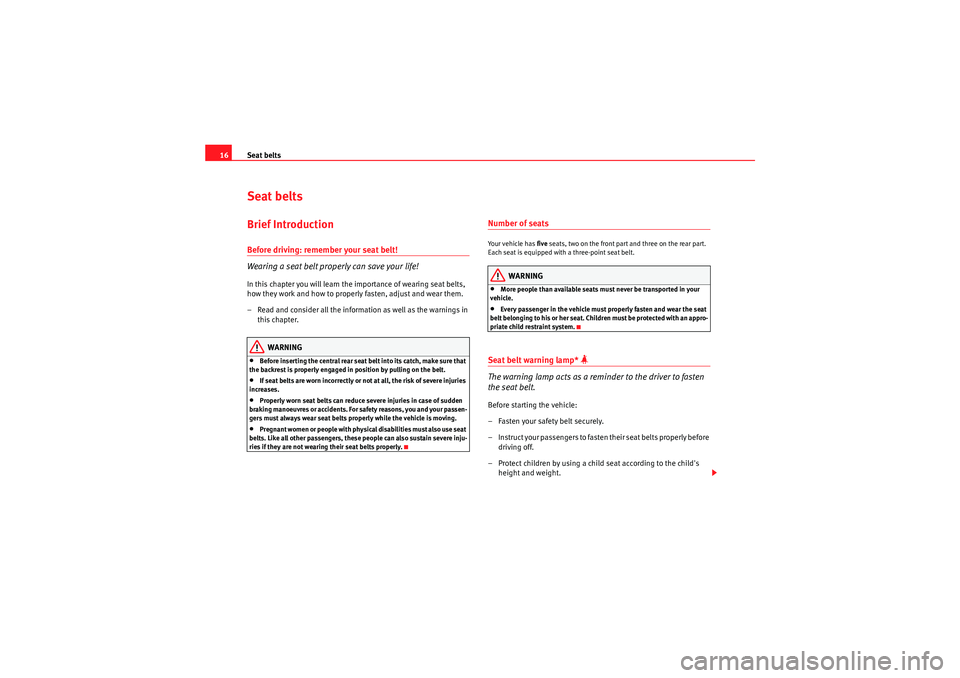
Seat belts
16Seat beltsBrief IntroductionBefore driving: remember your seat belt!
Wearing a seat belt properly can save your life!In this chapter you will learn the importance of wearing seat belts,
how they work and how to properly fasten, adjust and wear them.
– Read and consider all the informat ion as well as the warnings in
this chapter.
WARNING
•Before inserting the central rear seat belt into its catch, make sure that
the backrest is properly engaged in position by pulling on the belt.•If seat belts are worn incorrectly or not at all, the risk of severe injuries
increases.•Properly worn seat belts can reduce severe injuries in case of sudden
braking manoeuvres or accidents. For safety reasons, you and your passen-
gers must always wear seat belts properly while the vehicle is moving.•P r e g n a n t w o m e n o r p e o p l e w i t h p h y s i ca l d i s a b i l i t i e s m u s t a l s o u s e s e a t
belts. Like all other passengers, these people can also sustain severe inju-
ries if they are not wearing their seat belts properly.
Number of seatsYour vehicle has five seats, two on the front part and three on the rear part.
Each seat is equipped with a three-point seat belt.
WARNING
•More people than available seats must never be transported in your
vehicle.•Every passenger in the vehicle must properly fasten and wear the seat
belt belonging to h is or her s eat . Child ren m ust be protecte d with an appro-
priate child restraint system.
Seat belt warning lamp*
The warning lamp acts as a reminder to the driver to fasten
the seat belt.Before starting the vehicle:
–Fasten your safety belt securely.
– Instruct your passengers to fasten their seat belts properly before driving off.
– Protect children by using a child seat according to the child's height and weight.
IbizaSC_EN.book Seite 16 Mittwoch, 16. September 2009 12:11 12
Page 22 of 257
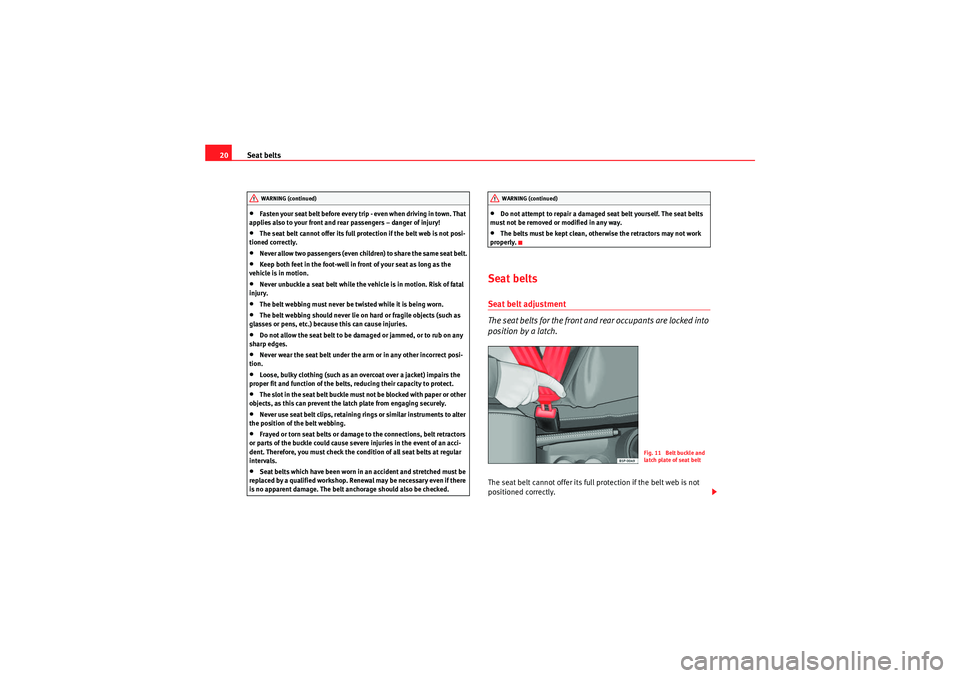
Seat belts
20•Fasten you r seat belt be fore ever y trip - even w hen dr iving in town . T hat
applies also to your front and rear passengers – danger of injury!•The seat belt cannot offer its full protection if the belt web is not posi-
tioned correctly.•Never allow two passengers (even children) to share the same seat belt.•Keep both feet in the foot-well in front of your seat as long as the
vehicle is in motion.•Never unbuckle a seat belt while the vehicle is in motion. Risk of fatal
injury.•The belt webbing must never be twisted while it is being worn.•The belt webbing should never lie on hard or fragile objects (such as
glasses or pens, etc.) because this can cause injuries.•Do not allow the seat belt to be damaged or jammed, or to rub on any
sharp edges.•Never wear the seat belt under the arm or in any other incorrect posi-
tion.•Loose, bulky clothing (such as an overcoat over a jacket) impairs the
proper fit and function of the belts, reducing their capacity to protect.•The slot in the seat belt buckle must not be blocked with paper or other
objects, as this can prevent the latch plate from engaging securely.•Never use seat belt clips, retaining rings or similar instruments to alter
the position of the belt webbing.•Frayed or torn seat belts or damage to the connections, belt retractors
or parts of the buckle could cause severe injuries in the event of an acci-
dent. Therefore, you must check the condition of all seat belts at regular
intervals.•Seat belts which have been worn in an accident and stretched must be
replaced by a qualified workshop. Renewal may be necessary even if there
is no apparent damage. The belt anchorage should also be checked.
•Do not attempt to repair a damaged seat belt yourself. The seat belts
must not be removed or modified in any way.•The belts must be kept clean, otherwise the retractors may not work
properly.
Seat beltsSeat belt adjustment
The seat belts for the front and rear occupants are locked into
position by a latch.The seat belt cannot offer its full protection if the belt web is not
positioned correctly.
WARNING (continued)
WARNING (continued)
Fig. 11 Belt buckle and
latch plate of seat belt
IbizaSC_EN.book Seite 20 Mittwoch, 16. September 2009 12:11 12
Page 24 of 257
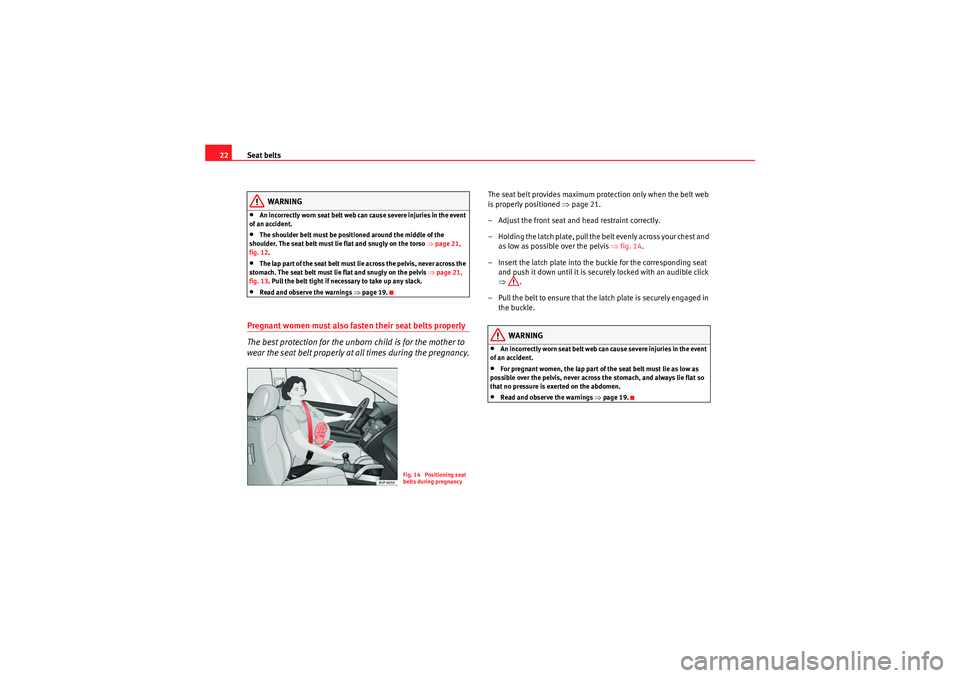
Seat belts
22
WARNING
•An incorrectly worn seat belt web can cause severe injuries in the event
of an accident.•The shoulder belt must be positioned around the middle of the
shoulder. The seat belt must lie flat and snugly on the torso ⇒page 21,
fig. 12.•The lap par t of the seat belt must lie across the pelvis, never across the
stomach. The seat belt must lie flat and snugly on the pelvis ⇒page 21,
fig. 13. Pull the belt tight if necessary to take up any slack.•Read and observe the warnings ⇒page 19.
Pregnant women must also fasten their seat belts properly
The best protection for the unborn child is for the mother to
wear the seat belt properly at all times during the pregnancy.
The seat belt provides maximum protection only when the belt web
is properly positioned ⇒page 21.
– Adjust the front seat and head restraint correctly.
– Holding the latch plate, pull the belt evenly across your chest and as low as possible over the pelvis ⇒fig. 14 .
– Insert the latch plate into the buckle for the corresponding seat and push it down until it is securely locked with an audible click
⇒ .
– Pull the belt to ensure that the latch plate is securely engaged in the buckle.
WARNING
•An incorrectly worn seat belt web can cause severe injuries in the event
of an accident.•For pregnant women, the lap part of the seat belt must lie as low as
possible over the pelvis, never across the stomach, and always lie flat so
that no pressure is exerted on the abdomen.•Read and observe the warnings ⇒page 19.
Fig. 14 Positioning seat
belts during pregnancy
IbizaSC_EN.book Seite 22 Mittwoch, 16. September 2009 12:11 12